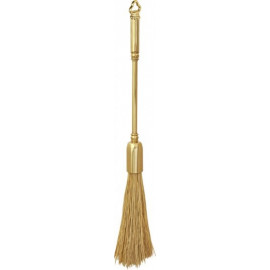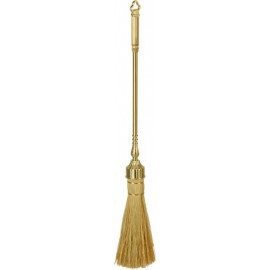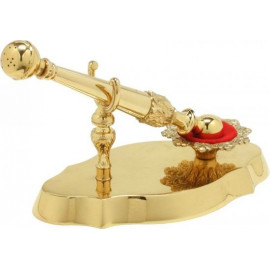No products
Product successfully added to your shopping cart
There are 0 items in your cart. There is 1 item in your cart.
Sprinkler
- Altar Bell and Gong
- Candle Snuffer
- Candlestick
- Catholic Pyx
- Chalices
- Church wall lamps
- Ciborium
- Crosses and Crucifix
- Cruets & Trays
- Holy Water Font
- Holy Water Pot
- Missal Stand
- Monstrance Tabor
- Monstrances
- Offering Baskets
- Oil Stock
- Patens
- Reliquaries
- Sanctuary Bells
- Sanctuary Lamp
- Sprinkler
- Thurible, Boat, & Spoon
- Travel Liturgy & Mass Kit
A holy water sprinkler, also known as an aspergillum, is a liturgical implement used to sprinkle holy water during religious ceremonies in Christian churches. The sprinkler is typically made of metal, such as brass or silver, and consists of a perforated ball at the end of a short handle. The sprinkler is used to sprinkle holy water on the faithful or on an object to be blessed. The aspergillum can be used in other manners where sprinkling of holy water is appropriate, as in a house blessing, during the Blessing of the Fleet, or as part of the ceremony consecrating an altar and a church building. The priest holds the aspergillum in his right hand while an acolyte holds the aspersorium, which is a holy water pot or bucket for use with an aspergillum.
A holy water sprinkler, also known as an aspergillum, is a liturgical implement used to sprinkle holy water during religious ceremonies in Christian churches. The sprinkler is typically made of metal, such as brass or silver, and consists of a perforated ball at the end of a short handle. The sprinkler is used to sprinkle holy water on the faithful or on an object to be blessed. The aspergillum can be used in other manners where sprinkling of holy water is appropriate, as in a house blessing, during the Blessing of the Fleet, or as part of the ceremony consecrating an altar and a church building. The priest holds the aspergillum in his right hand while an acolyte holds the aspersorium, which is a holy water pot or bucket for use with an aspergillum.
Sprinkler There are 3 products.
The Fascinating World of the Church Holy Water Sprinkler
The church holy water sprinkler, an object steeped in tradition and spirituality, serves as a bridge between the physical and the divine. This seemingly simple tool carries with it centuries of religious significance, embodying purification, protection, and blessing. Let's dive into the intriguing history, design, and uses of this sacred implement, making every sprinkle a story of faith and devotion.
What Exactly is a Church Holy Water Sprinkler?
A church holy water sprinkler, known in more formal circles as an aspergillum, is a liturgical instrument used to sprinkle holy water. It comes in various forms: from a brush-like bundle to a more elaborate metal ball with perforations, each designed to disperse holy water during religious ceremonies. This act of sprinkling is not just about physical cleansing, but symbolizes spiritual purification and the warding off evil.
The Rich History Behind the Sprinkler
The roots of the church holy water sprinkler stretch back to ancient times, intertwining with the practices of Judaism and early Christianity. Its evolution from a simple hyssop branch to the ornate instruments used today mirrors the church's journey through the ages. The aspergillum, as we know it, became a staple in Catholic liturgy around the 9th century, symbolizing the cleansing of the congregation's sins and protection against malevolent forces.
Design and Diversity: The Aspergillum's Many Faces
The design of the church holy water sprinkler varies widely, reflecting the cultural and regional nuances of the Christian world. The most common types include:
- The Brush Type: A simple, brush-like form that harks back to the earliest versions made from hyssop or other available plants.
- The Metal Ball: A more intricate design featuring a perforated sphere, often made of silver or brass, that evenly distributes holy water when shaken.
- The Sponge Type: Incorporates a sponge within a metal casing, allowing for a gentle release of water upon squeezing.
Each design serves the same sacred purpose, yet offers a unique aesthetic and tactile experience, enriching the ritual it's part of.
The Sprinkler in Action: More Than Just a Ritual
The use of the church holy water sprinkler is not limited to a single ceremony. It plays a pivotal role in various sacraments and blessings, including:
- Baptisms: Signifying the washing away of original sin and the rebirth of the soul.
- Easter Vigil: Marking the renewal of baptismal vows and the resurrection of Christ.
- Blessing of Homes and Objects: Invoking divine protection over personal spaces and items.
- Funerals: Offering a final purification for the departed soul.
In each of these moments, the sprinkler acts as a conduit of grace, transforming ordinary water into a symbol of God's omnipresent mercy.
FAQs: Unveiling the Mysteries of the Aspergillum
- Can anyone use a church holy water sprinkler?
While primarily a tool for priests and deacons, laypeople may use it for blessing their homes or personal items, always with reverence and prayer.
- How is holy water made?
Holy water is blessed by a priest, often incorporating prayers for protection and exorcism, making it a powerful sacramental.
- Why is salt sometimes added to holy water?
Salt, a symbol of preservation and purity, is mixed with holy water to enhance its sacramental efficacy against corruption and evil.
- Is the sprinkler used in all Christian denominations?
While most associated with Catholicism, Anglicanism, and Orthodoxy, its use varies among other Christian traditions.
In Conclusion: A Sprinkle of Faith
The church holy water sprinkler, with its deep historical roots and varied designs, remains a vital instrument of spiritual life. It's a reminder of the church's enduring rituals, the power of sacramentals, and the ever-present need for purification and protection in our spiritual journey. Every drop of holy water flung from an aspergillum carries with it centuries of faith, a tangible connection to the divine that continues to bless and sanctify the faithful across the globe.



